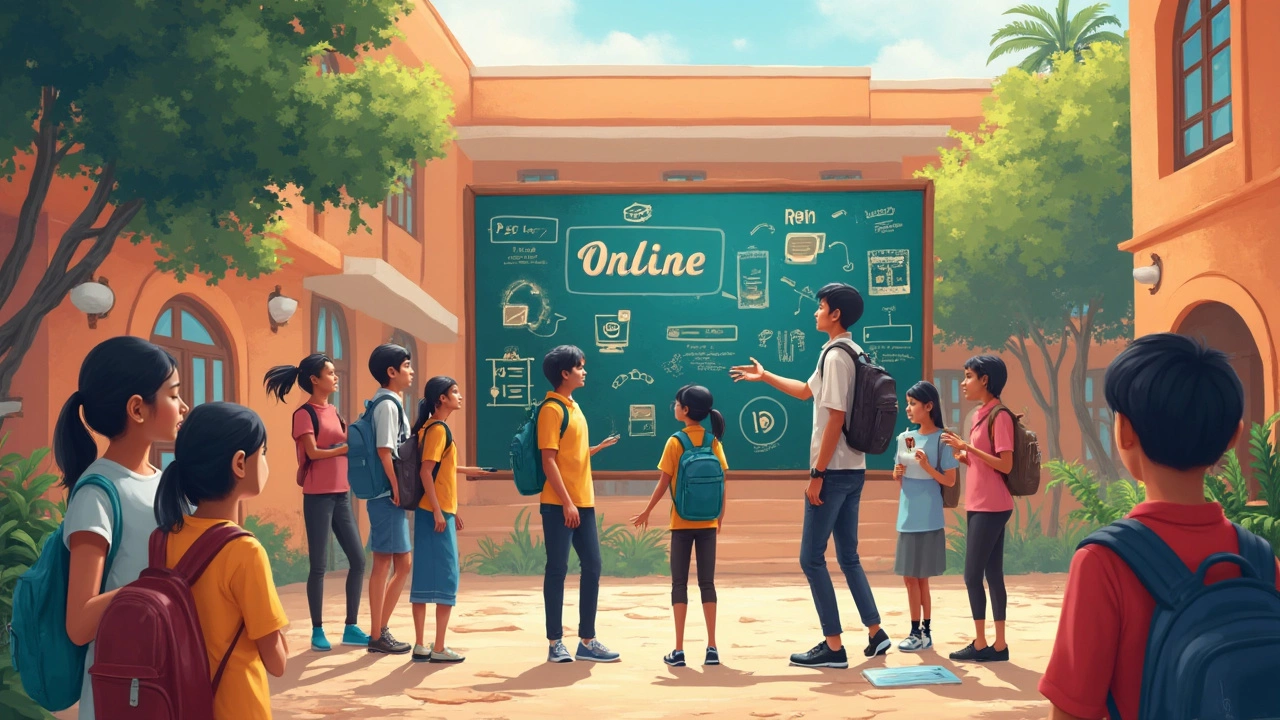Mistaking distance learning for online learning is easy—they both sound like you’re not sitting in a classroom. But there’s a real difference, and knowing which is which could actually save you lots of time and stress.
If you’re looking to study in your pajamas or need something that fits around your job, understanding these two options is a game changer. People use the terms interchangeably, but schools and job recruiters might see them differently. You don’t want to put “online degree” on a resume when you actually studied the old-school paper way via mail.
Let’s break down how each type works, and which one might click with your lifestyle and goals.
- What Exactly is Distance Learning?
- The Rise of Online Learning
- Key Differences You Should Know
- Picking the Right Method for You
- Tips for Success in Remote Education
What Exactly is Distance Learning?
Distance learning started long before the internet was a thing. Think of it as any kind of education where you aren’t physically in class with your teacher. The classic example? Getting assignments and course materials through the mail, finishing them at home, and mailing them back—no Zoom calls or live chats involved.
These days, distance learning covers both old-school paper-based courses and newer methods like DVDs or pre-recorded lectures that you watch on your own time. What matters is the lack of real-time interaction. You’re not logging in for a live lesson; you do your work whenever it fits your schedule, which is great for folks with busy jobs or family life.
Some schools still use this approach, especially for people who live far from a campus or have unreliable internet. Fun fact: The University of London started its External Programme way back in 1858, letting students literally learn from a distance while living on another continent. That’s about as retro as distance learning gets.
Real talk—if you pick distance learning, you’re usually on your own when it comes to organizing your week. There’s no professor making sure you attend class at a set time. This kind of setup is great if you’re self-driven and like working solo, but it can be tough if you need reminders or quick feedback.
Here’s what you usually get from a typical distance learning program:
- Study guides and textbooks mailed or emailed to you
- Assignments you submit by mail or through an online dropbox
- Little or no live group discussion
- Pre-recorded lectures (sometimes DVDs or downloads)
- Final exams you might take at a local test center
If you crave flexibility and don’t mind going at it alone, distance learning can open doors. But don’t expect fast answers if you get stuck—patience is key here.
The Rise of Online Learning
Not too long ago, the idea of earning a full degree from your laptop sounded strange. Now, online learning is all over the place, whether you’re trying to get a college degree or just picking up new skills for work. The push really started in the early 2000s when high-speed internet became standard in homes. Universities and companies quickly figured out they could reach more students without needing a classroom or even a building.
With platforms like Coursera, Udemy, and graduate schools offering entire programs online, you no longer need to be on campus. In 2024, over 65% of U.S. college students took at least one online learning course, according to the National Center for Education Statistics. People love the flexibility—pause your lecture for dinner or rewind if you missed something.
One reason online learning took off? The tech got better. Video calls, chat rooms, shared docs—they all made it feel more like a real class instead of awkward emails and scanned textbooks. Here’s how online learning usually works:
- Classes are accessed through a web platform, usually available 24/7.
- Lectures are often video-based, and some are live so you can ask questions in real time.
- Assignments, discussions, and grades all happen online, often with instant feedback.
- You connect with teachers and other students through chat or forums.
It’s not just for college kids either. Tons of adults are jumping in to switch careers or pick up new skills without having to quit their jobs. During the pandemic, everyone from high schoolers to working parents got a taste of online learning. Many liked it so much, they never went back.
Better yet, online learning often saves money. No daily commute, no housing, and sometimes cheaper tuition. Just be ready—self-motivation is key since nobody’s there to check you showed up for class.

Key Differences You Should Know
If you’re wondering why people stress about the distance learning vs online learning debate, it’s because the details can really matter—especially when it comes to how you want to study and what’s accepted by employers.
The biggest difference is the way things are delivered:
- Distance learning started long before the internet—picture getting course packets in the mail, reading textbooks on your own, and sending exams back by post. It’s about learning away from campus, but it doesn’t always mean it uses technology. Today, some distance courses are still mostly offline with printed materials and assignments you send in by mail or email.
- Online learning is exactly what it sounds like: everything’s on the internet. You get videos, quizzes, forums, and live sessions, usually with instant feedback. Lessons, materials, group projects—it all happens on your laptop or phone, anytime and anywhere with wifi.
Here are a few areas where things separate out:
- Interactivity: Online learning is interactive. You join chats, submit projects digitally, or jump on video calls. Distance learning can be a lot lonelier, and usually on your own schedule without live group work.
- Time to feedback: If you like fast feedback, online learning wins. Many courses use auto-graded quizzes or give you comments right away. Distance learning can take days or weeks for grades—especially if you send work by mail.
- Flexibility: Both offer flexibility; you aren’t stuck to a classroom clock. But with distance learning, you may have bigger windows to complete work, while online learning might mix deadlines with self-paced modules.
- Tech requirements: Online learning means you need a solid internet connection and a device. Distance learning can suit people with limited tech or who prefer working off-screen.
Check this quick table for a snapshot:
| Feature | Distance Learning | Online Learning |
|---|---|---|
| Main Delivery | Postal mail, email, printed materials | Internet: video, forums, LMS |
| Student Interaction | Minimal, often solo | Active: chats, video calls |
| Tech Needs | Low (can be offline) | High (needs internet/device) |
| Feedback Speed | Slow | Usually fast |
Knowing these differences matters, especially if you need quick support, group work, or don’t have reliable internet. Employers sometimes prefer online learning if they value tech skills and teamwork. But if your life demands extreme flexibility or low-tech options, classic distance learning can still be a smart pick.
Picking the Right Method for You
Making a choice between distance learning and online learning isn’t just about which sounds cooler, but which fits the way you live. There’s no universal “best”—it’s about what clicks with your schedule, comfort level with tech, and future plans.
Ask yourself a few questions before jumping in:
- How tech-savvy are you? Online learning will have you logging into platforms, joining video calls, doing digital quizzes, and using all kinds of apps. If you’re not comfortable with that, distance learning (old school mail, printed textbooks, phone support) might ease you in.
- How much interaction do you need? Online courses often include group work, real-time classes, or forums that mimic a classroom. Distance learning can be more solitary—fewer group chats, more self-guided reading.
- What’s your schedule like? If your work shifts change daily, you might want something asynchronous—most distance learning fits this. If you thrive on live interaction, online learning with live classes could be more your style.
- What’s recognized in your industry? Some industries look for programs with online proctoring, live sessions, or interactive components. It’s smart to check what employers or future schools expect from your education credentials.
Quick peek at real-life numbers: According to the National Center for Education Statistics, in 2023, about 60% of college students in the US took at least one online learning course. That tells you online isn’t just a pandemic trend—it’s the norm for a lot of people now.
| Factor | Online Learning | Distance Learning |
|---|---|---|
| Tech Involved | High | Low to moderate |
| Interaction | Frequent | Minimal |
| Flexibility | Some real-time commitments | Mostly self-paced |
| Assessment | Online quizzes, projects | Mail-in assignments, exams |
One last tip—talk to people already doing what you’re aiming for. A quick message on LinkedIn or a chat in a Facebook group can tell you whether a distance learning or online learning credential holds water in your field. Picking the right method is a smart move—don’t rush it.

Tips for Success in Remote Education
Taking on distance learning or online learning isn’t just about finding the right device or logging into a class. The setup, habits, and tools you pick can make or break your learning experience.
First things first, set up a real study space. A kitchen table works in a pinch, but if you can carve out a quiet corner, you’ll concentrate way better. Avoid working from bed—your body associates that with sleep, not spreadsheets or essays.
Routines matter. Try to start your work at the same time every day, even if you’re not a morning person. Students who stick to a schedule are 27% more likely to finish their courses, based on recent research from the National Center for Education Statistics. That routine helps your brain switch from ‘chill’ mode to ‘focus’ mode.
Tech glitches can ruin your momentum. Keep all your apps updated and test your internet before live classes or group calls. Bookmark your course page and keep track of key deadlines on a calendar—physical or digital, your pick.
- Don’t be shy about asking for help. Message your teachers or classmates when you’re stuck. Most online classes have discussion boards—use them!
- Break up your study time. 45-50 minute study blocks followed by short breaks work best. No one needs to pull an all-nighter on quiz prep.
- Stay organized. Use folders—either online or on your desk—for each subject or project. Messy notes get lost, and lost notes lead to panic.
If you’re juggling a job or family along with distance learning, communicate your schedule. My wife Clarissa and I share our plans every Sunday night so she knows when I’ll be locked down on schoolwork and when I can wrangle dinner or walk the dog. Makes life way smoother.
Lastly, reward yourself. Finishing a big assignment? Treat yourself to your favorite snack or a quick walk. Little rewards keep motivation high, especially when learning from home can feel a bit lonely sometimes.

